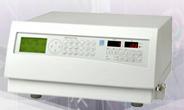|
Instrument Database:
Dionex Corporation - P680A HPG Binary High-Pressure Gradient Pump
| |
|

|
| |
|
| |
|
| Year of introduction |
|
| Status |
available |
| Company |
Dionex Corporation
|
| Categories |
Chromatography: LC/HPLC
|
|
Do you run demanding HPLC applications, such as microflow rate LC/MS or high sample throughput applications? Would you like to downscale your existing applications to use less sample, less solvents, and increase throughput? Then the P680A HPG Binary High-Pressure Gradient Pump is the right choice. With low flow rate applications, gradient delay volume is critical. The P680 HPG has a gradient delay volume of only 150 µL, which can be further reduced to less than 70 µL using an optional microflow kit. In addition, the gradient delay volume is independent of system backpressure (no pulse damper) eliminating shifting retention times due to changing backpressure. |  | Adapts to your needs—variable volume mixing chamber
The P680 HPG is equipped with a variable-volume mixing chamber. The standard configuration provides gradient delay volume of less than 150 µL. For low flow rates (e.g., <100 µL/min) a microflow kit reduces the gradient delay volume to less than 70 µL. For poorly miscible eluents, higher flow rates, or special applications, an extended mixer kit ensures complete eluent mixing. |  | Superior technology for microflow applications
At low flow rates, analytical low-pressure gradient systems have limited gradient proportioning capabilities. Some systems attempt to compensate for this with variable-piston stroke volumes. Dionex provides a better solution with the P680 HPG pump system. Its high-pressure gradient technology provides accurate and precise gradient formation at any flow rate, to as low as 50 µL/min. An optional microflow kit minimizes the gradient delay volume of the pump to less than 70 µL. Summit systems configured with the P680 HPG are ideal for applications requiring low flow rates, for example, in LC/MS. |  | Get your results faster—high sample throughput
The P680A HPG pump system allows for high sample throughput due to the very small delay volume. The small delay volume reduces the gradient delay time, especially important for fast analysis, thereby saving time and reducing eluent consumption. Fast gradient runs are particularly challenging for an HPLC pump system. They require highest gradient accuracy and precision. In addition, the compressibility of the eluent mixture—and therefore the system backpressure—changes rapidly. The P680’s unique in-stroke optimization algorithm synchronizes the movement of all pistons to compensate for pressure variations at every single stroke over the entire gradient run, automatically. The result is very low pressure pulsation—without the need of a pulse-damper—and excellent gradient accuracy and precision. |
|
| Specifications |
|
| P680A HPG Binary High-Pressure Gradient Pump Specifications | | Flow rate range | 1–10,000 µL/min (grad. mode)
1–20,000 µL/min (double flow mode) | | Flow rate accuracy and reproducibility | ±0.1% at 1 mL/min | | Gradient formation | Binary (with opt. solvent selector: from 4 solvents) | | Pressure range | 0.1–50 MPa (7250 psi) | | Pressure ripple | Typically <1% | | Proportioning accuracy | ±0.2% at 2 mL/min | | Proportioning reproducibility | ±0.2% at 2 mL/min | | Number of solvents | Two, optional four (gradient formation two from four) | | Gradient delay volume (standard pump) | <150 µL | | Solvent degassing | External (optional) | | Remote control | All functions controllable through LAN or USB
Permanent status transfer
Program-controlled or stand-alone operation | | I/O interfaces | Three digital inputs for Start, Stop, and Hold
Four programmable relays
Motorized switching-valve port
Analog output for system pressure | | PC connection | USB or TCP/IP (RJ-45) | | Additional communication ports | RS-232 port for connection of an ASI-100 TM Autosampler or STH-585 Column Thermostat | | Additional USB ports | Integrated USB hub with three type A USB ports for connection of other Summit HPLC modules | | Safety features | Minimum/maximum pressure shutdown (selectable)
Time monitoring of pump functions
Leak sensors | | User input/display | Keypad (solvent-resistant)
Eight-line LCD (21 characters per line)
11 LEDs
User input is possible while a program is active | | Wetted parts | Stainless steel (1.4571), sapphire, ruby, ceramics, UHMW polyethylene, PCTFE, PTFE, PEEK, zirconimum oxide (ZrO2), aluminium oxide (Al2O3) | | Power requirements | Max. 80 W (100–120 V, 60 Hz; 200–240 V, 50 Hz) | | Operating conditions | Temperature: 10–35 °C (50–95 °F)
Air humidity: 40–85% relative humidity, noncondensing
Overvoltage category: II
Pollution degree: 2 | Dimensions
(h × w × d) | 19 × 40 × 38 cm (7.5 × 15.8 × 15.0 in.) | | Weight | 15.8 kg (34.8 lb) |
|
|